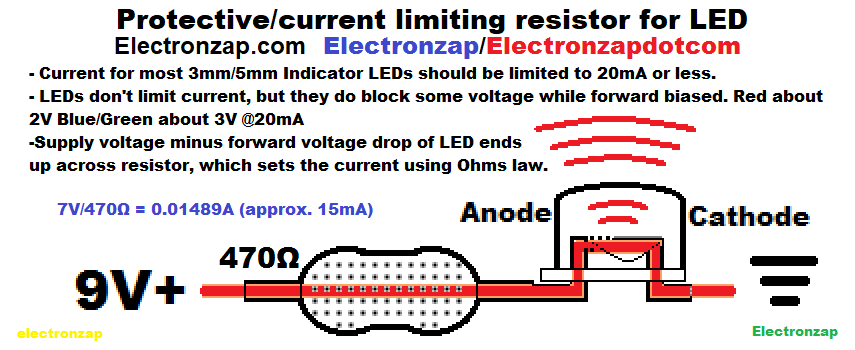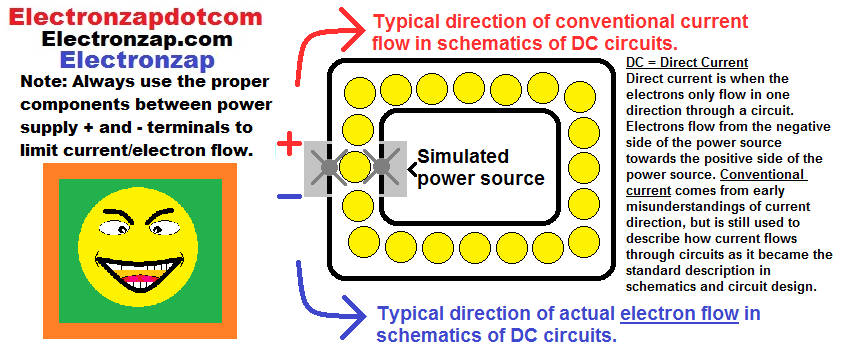Table of Contents
You can’t see electricity, but you can notice it’s effects. So, it helps to visualize electric current/electrons flowing while you analyze, design, or build a circuit.

- Conventional current. Imaginary fluid like substance moving from more positive to more negative.
- Electron flow. Subatomic particles (electrons) that really exist and flow from negative to positive.

- Yellow dots in the diagram above indicate moving charges. Either negatively charged electrons or imaginary positively charged current charge carriers.
- One way to imagine flow is that the simulated power source paddles rotating the positive charge carrier dots clockwise from positive, through the load (not illustrated above), and back to the negative side of the power supply. Don’t forget that in real circuits, you need components along that path in order to dissipate power.
- Conventional current is typically imagined while designing or building a circuit due to it being how electricity was imagined before electrons were discovered in the early years of electronics study. Ground is usually considered 0V and typically assigned to the negative side of a single power supply. Single supplies are typically what is used to power DC circuits.
- Another way you can imagine flow is that the paddles push large batches (Coulombs) of electrons from the negative supply, through the load (not illustrated above but needed in actual circuits), and back to the positive supply.
- Atoms are really made of Protons and Electrons. So, although you can’t see them, it helps to understand how they interact with neighboring atoms in order to better understand the electrical properties of different materials. Especially semi conductive material.
- One way to imagine flow is that the simulated power source paddles rotating the positive charge carrier dots clockwise from positive, through the load (not illustrated above), and back to the negative side of the power supply. Don’t forget that in real circuits, you need components along that path in order to dissipate power.
Resistance:

Resistance limits current flow from a given voltage. Behaving much like how the size of a water pipe limits the amount of water that flows through it for a given pressure.
The relationship between voltage, current and resistance is linear. Twice the voltage across a given resistance, equals twice the current through that resistance.
- 1 volt will push 1 amp of current through a resistance of 1 ohm. Don’t do that though unless it is at least rated to dissipate at least 2 watts!
- 2V will push 2A of current through a resistance of 1Ω. Don’t do that though unless it is at least rated to dissipate at least 8 watts!
- 1 volt will push 0.001 amp (1 milliamp) of current through a 1,000 ohm resistance.
- 2V will push 0.002A (2mA) of current through a resistance of 1,000Ω.

The “friction” from current flowing through resistance creates heat. The heat, or power (P) in watts, produced by a component can be calculating by multiplying the volts across it, by the amps through it. P = VI. Always make sure a component is rated for at least twice as much wattage as it will be expected to dissipate.

It is more accurate to think of electrons as shown above.
- Good conductors are made up of atoms with a single valence (outer most) electron. Since the valence electron is relatively far away from the atom nucleus, it can be moved to other atoms really easily.
- Good insulators have a number of electrons in their valence (outer most) shell, and are therefore held more tightly by multiple protons in the nucleus.
Topics to be added:
- Coulombs
To support this site, check out the following links:
Art of electronics is easily my favorite learning electronics book. It helps to already be familiar with basic electronics while studying it. It inspires many of my demonstration circuits. An affiliate link ad that supports this site.
- Become a Patron!
- Check out my YouTube videos! https://www.youtube.com/c/Electronzap/videos
- Products I used in my videos or otherwise think look like a good buy. As an Amazon associate, I earn from qualifying purchases. https://www.amazon.com/shop/electronzapdotcom
- Information on this site is not guaranteed to be accurate. Always consult the manufacturer info/datasheet of parts you use. Research the proper safety precautions for everything you do.
- Electronzap is a participant in the Amazon Services LLC Associates Program, an affiliate advertising program designed to provide a means for sites to earn advertising fees by advertising and linking to amazon.com.